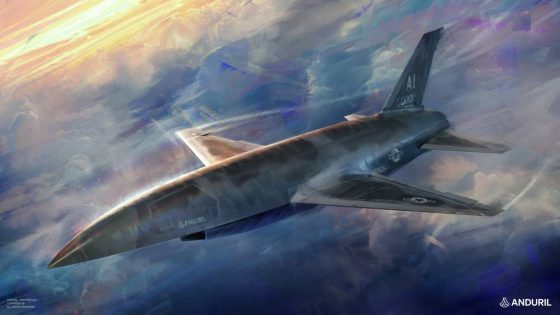The U.S. Air Force on Wednesday announced it selected Anduril and General Atomics to keep designing, building and testing its first batch of drone wingmen known as collaborative combat aircraft.
The decision on contract option awards marks the serviceâs most significant step yet as it aims to create a series of drones using autonomous software to fly alongside piloted fighters, such as the F-35 and Next Generation Air Dominance system.
The Air Force has made the CCA program one of its key efforts to modernize its fleet with advanced capabilities. The service wants CCAs to be less expensive than piloted aircraft, but still able to carry out airstrikes, conduct reconnaissance or perform electronic warfare operations in combat, thus expanding the reach of crewed planes.
Anduril and General Atomics will now further develop detailed designs of their CCA concepts and build production-representative test aircraft for the Air Force. The service expects to follow this first increment of CCAs with a second wave of more advanced aircraft.
The service could field at least 1,000 CCAs, and the fleet is likely to include multiple types of drone wingmen with differing capabilities and levels of survivability.
âJust over two years ago, we announced our intent ⦠to pursue collaborative combat aircraft,â Air Force Secretary Frank Kendall said in the serviceâs news release. âNow, following the enactment of the fiscal year 2024 budget, weâre exercising option awards to two companies to construct production representative test articles. The progress weâve made is a testament to the invaluable collaboration with industry, whose investment alongside the Air Force has propelled this initiative forward.â
General Atomics is pitching its autonomous collaborative drone known as Gambit as the Air Forceâs first CCA. General Atomics unveiled Gambit two years ago, and said its advanced artificial intelligence and autonomous software will help provide high-quality intelligence, surveillance and reconnaissance, and be able to sense and track targets of interest.
General Atomics spokesman C. Mark Brinkley said the companyâs CCA design is a derivative of the XQ-67 drone the Air Force Research Laboratory earlier this year flew to test out a âplatform sharingâ construction concept.
Under that approach, the XQ-67 was built on a chassis that could provide a common foundation for multiple kinds of drones, which AFRL said could lower costs and allow greater mass production.
âThe CCA program redefines the future of aviation and will shape the USAF acquisition model to deliver affordable combat mass to the warfighter at the speed of relevancy,â Mike Atwood, vice president of advanced programs for General Atomics Aeronautical Systems said in a statement. The Air Force âis moving forward with [General Atomics Aeronautics] due to our focused commitment to unmanned air-to-air combat operations and unmatched UAS experience, ensuring the production of the CCA aircraft at scale to deliver affordable combat mass for the warfighter.â
Andurilâs bid for CCA is called Fury. The company said Fury uses its Lattice operating system to provide autonomous capabilities and team up with piloted aircraft during operations.
âThere is no time to waste on business as usual,â Anduril chief executive Brian Schimpf said in a release. âWith the CCA program, Sec. Kendall and the Air Force have embraced a fast-moving, forward-looking approach to field autonomous systems at speed and scale. … Anduril is proud to pave the way for other non-traditional defense companies to compete and deliver on large-scale programs.â
The service did not respond to a Defense News inquiry asking for the value of each option award.
The two firms were part of an initial group of five companies, also including Lockheed Martin, Boeing and Northrop Grumman, that had contracts to work on CCAs. Kendall said in February that the Air Force wanted to whittle that list down to three at first, but said a total of two was more likely due to tight budgets.
The three companies not selected for these contract options will have further opportunities to work on the next wave of the program, the Air Force said. They will remain in the broader pool of more than 20 industry partners working on CCAs and can compete for future production contracts â including production of the first increment of the program â and other efforts.
Not all vendors on the CCA program are working on the air vehicle. Andrew Hunter, the Air Forceâs assistant secretary for acquisition, technology and logistics, told reporters in February that some are working on software allowing them to fly autonomously â which he said was the hardest part of the program â among other elements.
Hunter said in February that the service is confident the first increment of CCAs will be able to operate autonomously, but that âwill be more limitedâ than what subsequent generations will be able to do.
âAs we navigate the next phase of CCA development, our collaboration with both current and potential industry partners remains pivotal,â Hunter said in Wednesdayâs statement. âTheir expertise, innovation and resources are instrumental in driving this initiative forward, ensuring its success and impact on future operations.â
The Air Force plans to make a decision on a contract to produce the first increment of CCAs in fiscal 2026, and field fully operational drone wingmen by the end of this decade.
The Air Force said it is already planning to develop the second increment of CCAs, and the first activities for this other increment will start later this year.
âContinuous competition is a cornerstone at every stage of this program,â Kendall said. âThe transparency and teamwork between industry and government really accelerated how quickly we could mature the CCA program.â
Stephen Losey is the air warfare reporter for Defense News. He previously covered leadership and personnel issues at Air Force Times, and the Pentagon, special operations and air warfare at Military.com. He has traveled to the Middle East to cover U.S. Air Force operations.
Source Agencies


